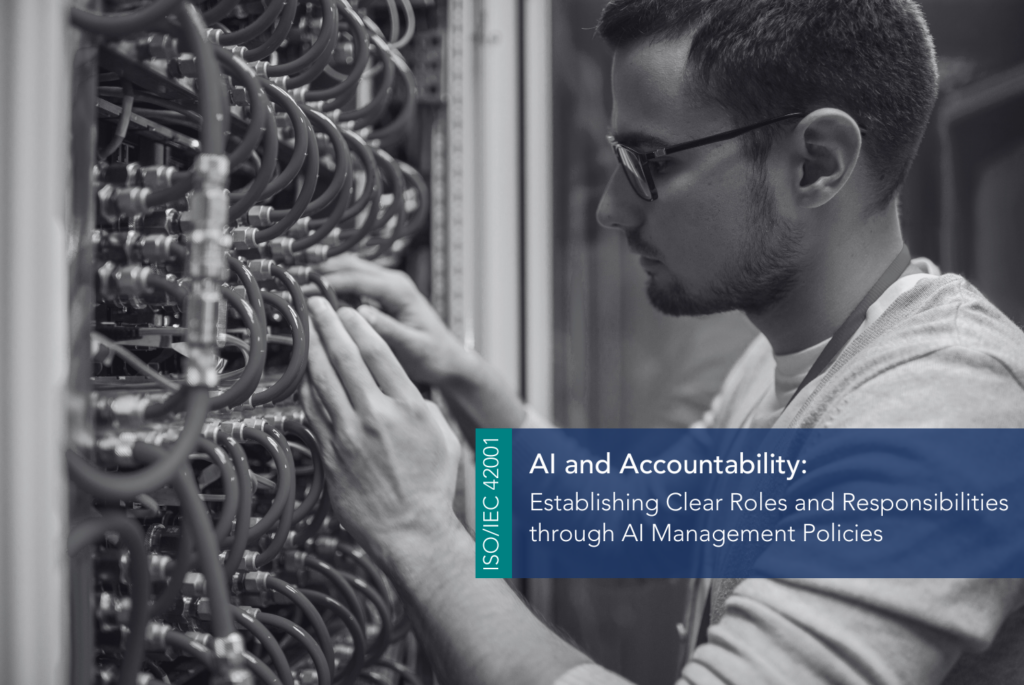
AI and Accountability
August 5th, 2024 By AmywrightIn artificial intelligence (AI), ensuring accountability is paramount for successfully deploying and operating AI systems. Clear roles and responsibilities within AI projects are essential to foster accountability, maintain trust, and uphold ethical standards. This blog will discuss the importance of defining roles and responsibilities in AI projects and provide a framework for creating an AI management policy that outlines the responsibilities of different stakeholders.
5 Ways To Define Roles and Responsibilities
Enhancing Accountability: When roles and responsibilities are clearly defined, holding individuals and teams accountable for their actions and decisions becomes more accessible. This accountability ensures that every aspect of the AI project is managed diligently, reducing the risk of errors and ethical breaches.
Ensuring Compliance: Clearly defined roles help ensure compliance with relevant laws, regulations, and ethical guidelines. By assigning specific compliance responsibilities to designated roles, organizations can better navigate the complex legal landscape of AI.
Improving Efficiency: Defined roles and responsibilities streamline workflows and improve efficiency. Team members know exactly what is expected of them, reducing overlap and confusion. This clarity helps in the efficient allocation of resources and timely completion of tasks.
Facilitating Communication: Clear roles and responsibilities enhance communication within the team and with external stakeholders. When everyone knows their role, communication becomes more structured and effective, leading to better collaboration and decision-making.
Building Trust: Transparency in roles and responsibilities builds trust among team members, stakeholders, and customers. It shows that the organization is committed to ethical AI practices and is taking deliberate steps to ensure accountability.
Framework for Creating an AI Management Policy
Creating an AI management policy involves outlining the roles and responsibilities of various stakeholders involved in the AI project. Here is a step-by-step framework for developing such a policy:
Identify Stakeholders:
Determine all the stakeholders involved in the AI project, including internal team members (developers, data scientists, project managers), external partners, customers, and regulatory bodies.
Define Key Roles:
Clearly define the key roles required for the AI project. These roles might include:
- Project Manager: This person oversees the entire project, ensures milestones are met, and acts as the primary point of contact.
- Data Scientist: Handles data collection, processing, and model training. Ensures the data used is ethical and unbiased.
- AI Developer: Develops and implements AI algorithms and models.
- Compliance Officer: Ensures the project complies with legal, regulatory, and ethical standards.
- Quality Assurance Specialist: Tests and validates the AI systems to ensure they meet the required standards.
Assign Responsibilities:
Outline the specific responsibilities associated with each role. For example:
- Project Manager: Responsible for project planning, resource allocation, risk management, and stakeholder communication.
- Data Scientist: Ensures data integrity, addresses biases, and maintains data security.
- AI Developer: Develops ethical and efficient AI models, adheres to coding standards, and performs regular updates.
- Compliance Officer: Monitors regulatory changes audits, and ensures all practices comply with relevant laws.
- Quality Assurance Specialist: Conducts thorough testing, identifies issues, and ensures the AI system operates as intended.
Establish Reporting Lines:
Define clear reporting lines and communication channels. Ensure each team member knows whom to report to and how to escalate issues when necessary.
Develop Monitoring and Evaluation Processes:
Implement processes for regular monitoring and evaluation of the AI systems. Assign specific roles to the responsibility of ongoing assessments to ensure the systems operate ethically and effectively.
Create a Response Plan:
Develop a response plan for addressing ethical, legal, or operational issues. Assign roles for incident management, investigation, and resolution.
Document and Communicate the Policy:
Document the AI management policy in a clear and accessible format. Ensure all team members and stakeholders know the policy and their roles and responsibilities.
Defining roles and responsibilities in AI projects is fundamental to ensuring accountability and fostering trust. By implementing a comprehensive AI management policy, organizations can confidently navigate the complexities of AI deployment. Having policies in place enhances efficiency and compliance. It builds a solid foundation of AI practices that can withstand scrutiny and create trust among customers and stakeholders.
As AI continues to evolve, the importance of accountability and clear role definition will only grow. Organizations that prioritize these aspects will be well-positioned to harness AI’s full potential while maintaining the highest standards of integrity and transparency. Contact one of our experts today to learn how your business can implement AI Management effectively.

Contact Us
For a free Quotation or On-Site presentation by an ISO Specialist, contact us today!
IMSM Canada Ltd
The Exchange Tower, PO Box 427
130 King Street West Suite 1900
Toronto, M5X 1E3